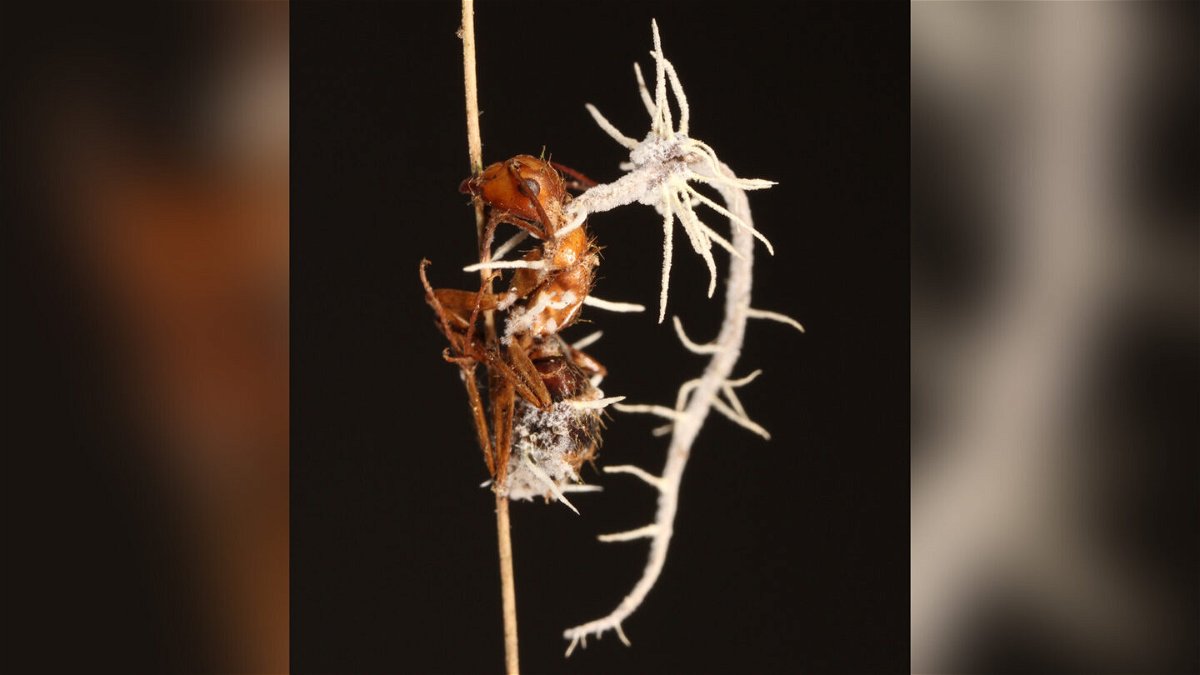Mystery parasites on zombie ant fungus identified by scientists

One of the new fungi
By Kate Golembiewski, CNN
Around the world, a parasitic fungus transforms ants into “zombies.”
The fungus is like something out of a horror movie: The organism hijacks the body and brain of its ant host, mind-controlling it into abandoning its nest and climbing a nearby tree.
There, the infected ant clamps its jaws around a leaf, dangling above the forest floor, and dies in a matter of days as the fungus digests it. Bursting through its host’s body, the fungus then sends down a shower of spores to infect the next generation of ant prey.
Scientifically categorized in the genus Ophiocordyceps, the more than two dozen species of zombie ant fungus populate the globe, including Florida, Brazil and Japan; scientists suspect that each of the dozens of ant species affected has its own specialized Ophiocordyceps strain.
So far, scientists have figured out the molecular mechanism of the parasitic interaction between fungus and ant that forms the basis of the behavioral manipulation, according to a 2020 study. How exactly these parasites systematically operate, however, is poorly understood.
Now, scientists have revealed that the ant-attacking fungus is infected with fungal parasites of its own, which could be helping to keep ant zombification in check, according to a new study.
Mystery fungus
Dr. João Araújo, an assistant curator of mycology at the New York Botanical Garden, has been trekking through tropical forests in search of zombie ants for more than a decade. Over the years, he kept noticing something strange: a fuzzy white fungus growing on top of the zombie ant fungus.
Other scientists have noted the mystery fungus for decades, but Araújo and his colleagues decided to become the first scientists to systematically dig into the matter, zeroing in on a strain of zombie ants from Florida. The researchers described the physical structure of the fungi growing on top of the zombie ant fungus and sequenced their DNA in a study published November 9 in the journal Persoonia.
In doing so, the team discovered two new genera of fungus previously unknown to science.
“We realized that there were two different lineages of fungi, novel lineages of fungi, infecting one species of zombie ant fungus in Florida,” said Araújo, the study’s lead author.
Each of the two newly discovered fungi belongs to its own genus. One of the new fungi, Niveomyces coronatus, is responsible for the fuzzy white coating on the zombie ant fungus — a component of its name (“niveo”) comes from the Latin for “snowy.” The second new fungus, Torrubiellomyces zombiae, is harder to spot: The little black blobs “look like fleas,” according to Araújo.
Checks and balances
The fungi attacking the zombie ant fungus don’t, in turn, zombify their host, but they do feed on its tissues and appear to cause it harm. “Every time we see these new genera we described growing on the fungus, the fungus looks pretty beaten up, really consumed by this other fungus,” Araújo said.
“In some cases, it castrates Ophiocordyceps (the zombie-making fungus) first, so it cannot shoot the spores anymore, and then it grows and then consumes the whole fungus.” Since Niveomyces and Torrubiellomyces are so new to science, it’s not yet clear how much of an effect they have on zombie ant fungi populations overall.
These new genera are the first parasites officially described as infecting the zombie ant fungus, but the researchers suspect there could be others out there. “I think it’s more common than we think. Parasitism is a super lucrative sort of lifestyle,” said senior study author Dr. Charissa de Bekker, an assistant professor at Utrecht University in the Netherlands. “It might be the most dominant lifestyle on the planet.”
Additional research needed
What’s more, she said, parasites in general and parasitic fungi in particular are poorly studied. “The fact that we had to invoke two new genera tells you how little we know about this part of the fungal tree of life,” de Bekker said.
By deepening our understanding of the zombie ant fungus, the new research could have applications that go beyond the study of fungi, said Dr. Carolyn Elya, a postdoctoral fellow in organismic and evolutionary biology at Harvard University. She was not involved with the study.
“Ophiocordyceps has basically over evolutionary time become an expert neuroscientist. It knows exactly what buttons to push and how to get the ant to do what it wants,” she said. “By studying how it’s figured out how to solve this problem, we can have insight into our more general goal of trying to understand how brains work or produce behavior.”
The-CNN-Wire
™ & © 2022 Cable News Network, Inc., a Warner Bros. Discovery Company. All rights reserved.
Kate Golembiewski is a freelance science writer based in Chicago who geeks out about zoology, thermodynamics and death. She hosts the comedy talk show “A Scientist Walks Into a Bar.”



